Impact of Technology on Managing the Digital Enterprise Report
VerifiedAdded on 2021/05/31
|12
|3422
|26
Report
AI Summary
This report delves into the intricacies of managing the digital enterprise, with a specific focus on supply chain management. It begins by defining supply chain and supply chain management, emphasizing the importance of efficiency and the role of digital communication in facilitating effective information sharing. The report explores various supply chain issues, such as globalization, market changes, and quality concerns, providing real-world examples from industries like McDonald's, BMW, and Walmart. It then highlights the assistance of technologies like AI, IoT, and blockchain in overcoming these issues and enabling seamless information exchange. The report also discusses the potential challenges of incorporating technology and IoT, including security issues and integration complexities, concluding with a comprehensive overview of the digital enterprise and its impact on supply chain efficiency. The report is available on Desklib, a platform offering AI-based study tools and resources for students.
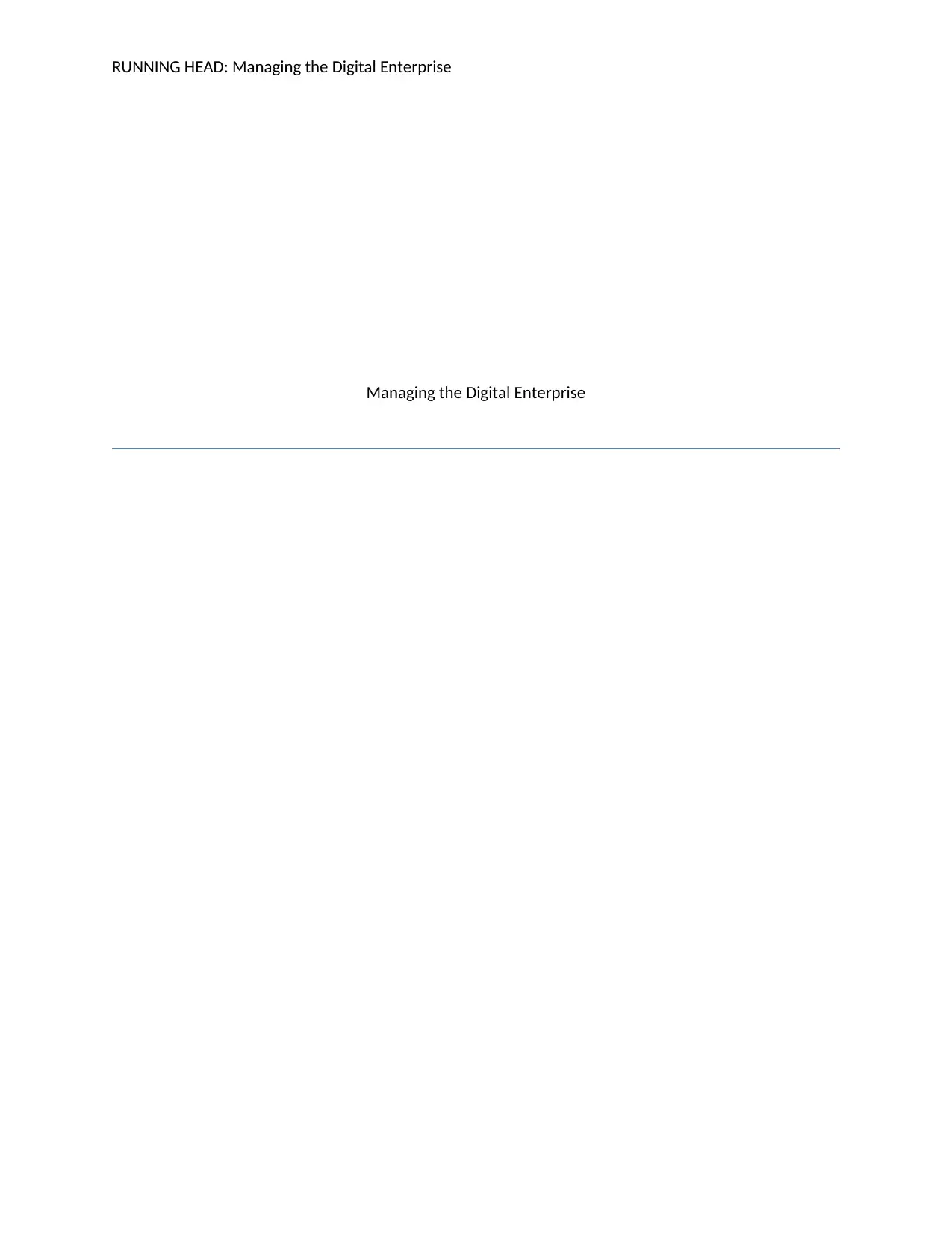
RUNNING HEAD: Managing the Digital Enterprise
Managing the Digital Enterprise
Managing the Digital Enterprise
Paraphrase This Document
Need a fresh take? Get an instant paraphrase of this document with our AI Paraphraser
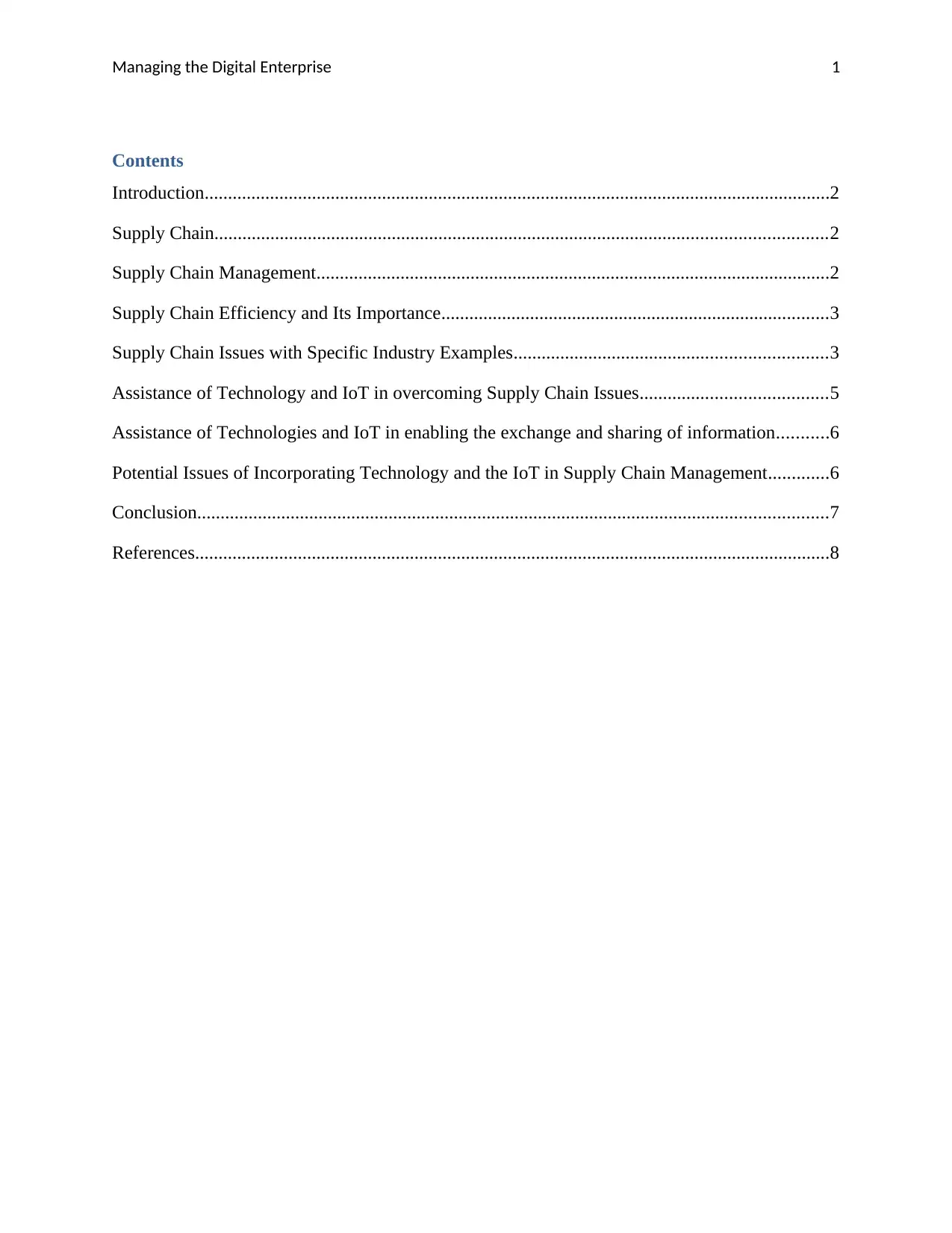
Managing the Digital Enterprise 1
Contents
Introduction......................................................................................................................................2
Supply Chain...................................................................................................................................2
Supply Chain Management..............................................................................................................2
Supply Chain Efficiency and Its Importance...................................................................................3
Supply Chain Issues with Specific Industry Examples...................................................................3
Assistance of Technology and IoT in overcoming Supply Chain Issues........................................5
Assistance of Technologies and IoT in enabling the exchange and sharing of information...........6
Potential Issues of Incorporating Technology and the IoT in Supply Chain Management.............6
Conclusion.......................................................................................................................................7
References........................................................................................................................................8
Contents
Introduction......................................................................................................................................2
Supply Chain...................................................................................................................................2
Supply Chain Management..............................................................................................................2
Supply Chain Efficiency and Its Importance...................................................................................3
Supply Chain Issues with Specific Industry Examples...................................................................3
Assistance of Technology and IoT in overcoming Supply Chain Issues........................................5
Assistance of Technologies and IoT in enabling the exchange and sharing of information...........6
Potential Issues of Incorporating Technology and the IoT in Supply Chain Management.............6
Conclusion.......................................................................................................................................7
References........................................................................................................................................8
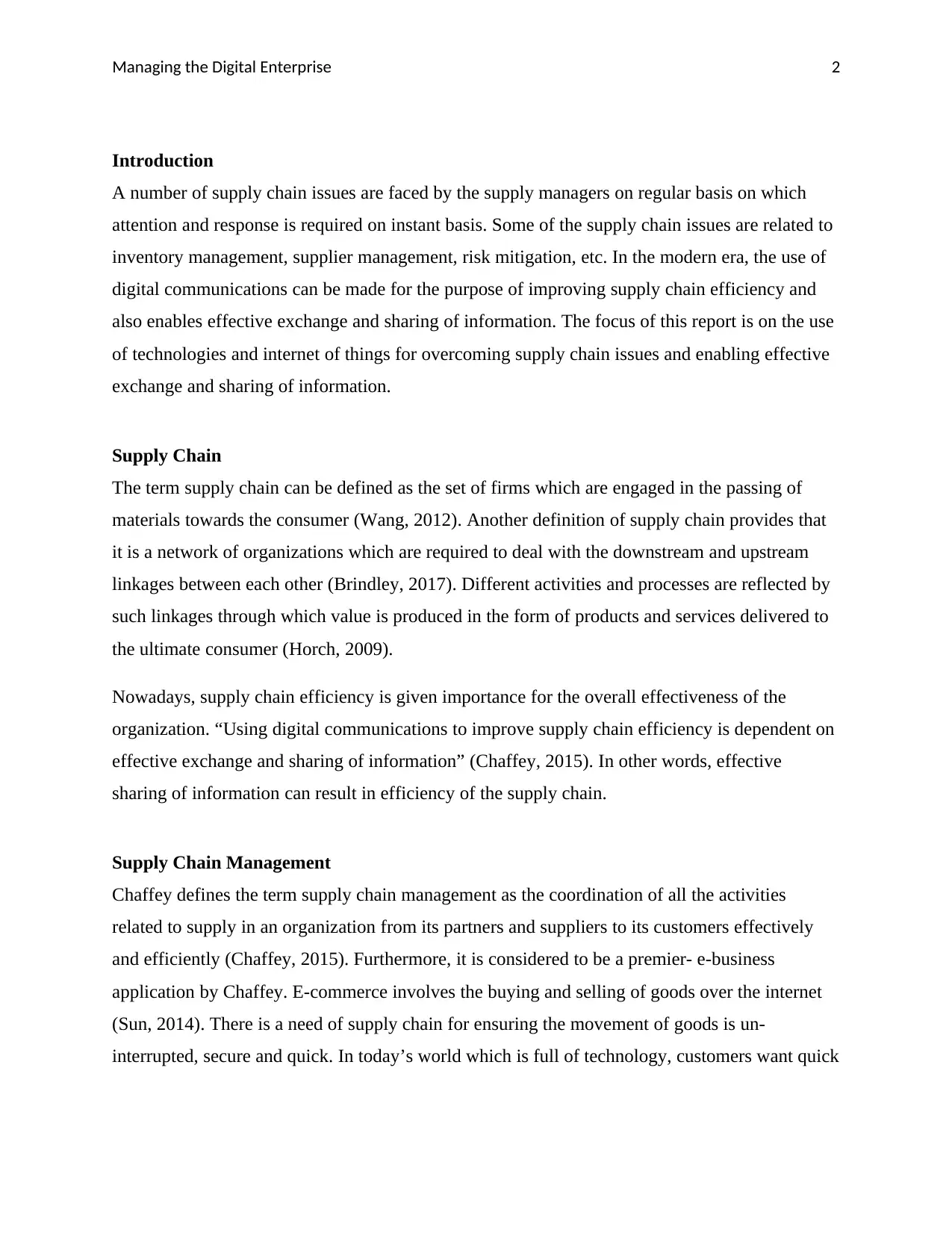
Managing the Digital Enterprise 2
Introduction
A number of supply chain issues are faced by the supply managers on regular basis on which
attention and response is required on instant basis. Some of the supply chain issues are related to
inventory management, supplier management, risk mitigation, etc. In the modern era, the use of
digital communications can be made for the purpose of improving supply chain efficiency and
also enables effective exchange and sharing of information. The focus of this report is on the use
of technologies and internet of things for overcoming supply chain issues and enabling effective
exchange and sharing of information.
Supply Chain
The term supply chain can be defined as the set of firms which are engaged in the passing of
materials towards the consumer (Wang, 2012). Another definition of supply chain provides that
it is a network of organizations which are required to deal with the downstream and upstream
linkages between each other (Brindley, 2017). Different activities and processes are reflected by
such linkages through which value is produced in the form of products and services delivered to
the ultimate consumer (Horch, 2009).
Nowadays, supply chain efficiency is given importance for the overall effectiveness of the
organization. “Using digital communications to improve supply chain efficiency is dependent on
effective exchange and sharing of information” (Chaffey, 2015). In other words, effective
sharing of information can result in efficiency of the supply chain.
Supply Chain Management
Chaffey defines the term supply chain management as the coordination of all the activities
related to supply in an organization from its partners and suppliers to its customers effectively
and efficiently (Chaffey, 2015). Furthermore, it is considered to be a premier- e-business
application by Chaffey. E-commerce involves the buying and selling of goods over the internet
(Sun, 2014). There is a need of supply chain for ensuring the movement of goods is un-
interrupted, secure and quick. In today’s world which is full of technology, customers want quick
Introduction
A number of supply chain issues are faced by the supply managers on regular basis on which
attention and response is required on instant basis. Some of the supply chain issues are related to
inventory management, supplier management, risk mitigation, etc. In the modern era, the use of
digital communications can be made for the purpose of improving supply chain efficiency and
also enables effective exchange and sharing of information. The focus of this report is on the use
of technologies and internet of things for overcoming supply chain issues and enabling effective
exchange and sharing of information.
Supply Chain
The term supply chain can be defined as the set of firms which are engaged in the passing of
materials towards the consumer (Wang, 2012). Another definition of supply chain provides that
it is a network of organizations which are required to deal with the downstream and upstream
linkages between each other (Brindley, 2017). Different activities and processes are reflected by
such linkages through which value is produced in the form of products and services delivered to
the ultimate consumer (Horch, 2009).
Nowadays, supply chain efficiency is given importance for the overall effectiveness of the
organization. “Using digital communications to improve supply chain efficiency is dependent on
effective exchange and sharing of information” (Chaffey, 2015). In other words, effective
sharing of information can result in efficiency of the supply chain.
Supply Chain Management
Chaffey defines the term supply chain management as the coordination of all the activities
related to supply in an organization from its partners and suppliers to its customers effectively
and efficiently (Chaffey, 2015). Furthermore, it is considered to be a premier- e-business
application by Chaffey. E-commerce involves the buying and selling of goods over the internet
(Sun, 2014). There is a need of supply chain for ensuring the movement of goods is un-
interrupted, secure and quick. In today’s world which is full of technology, customers want quick
⊘ This is a preview!⊘
Do you want full access?
Subscribe today to unlock all pages.

Trusted by 1+ million students worldwide
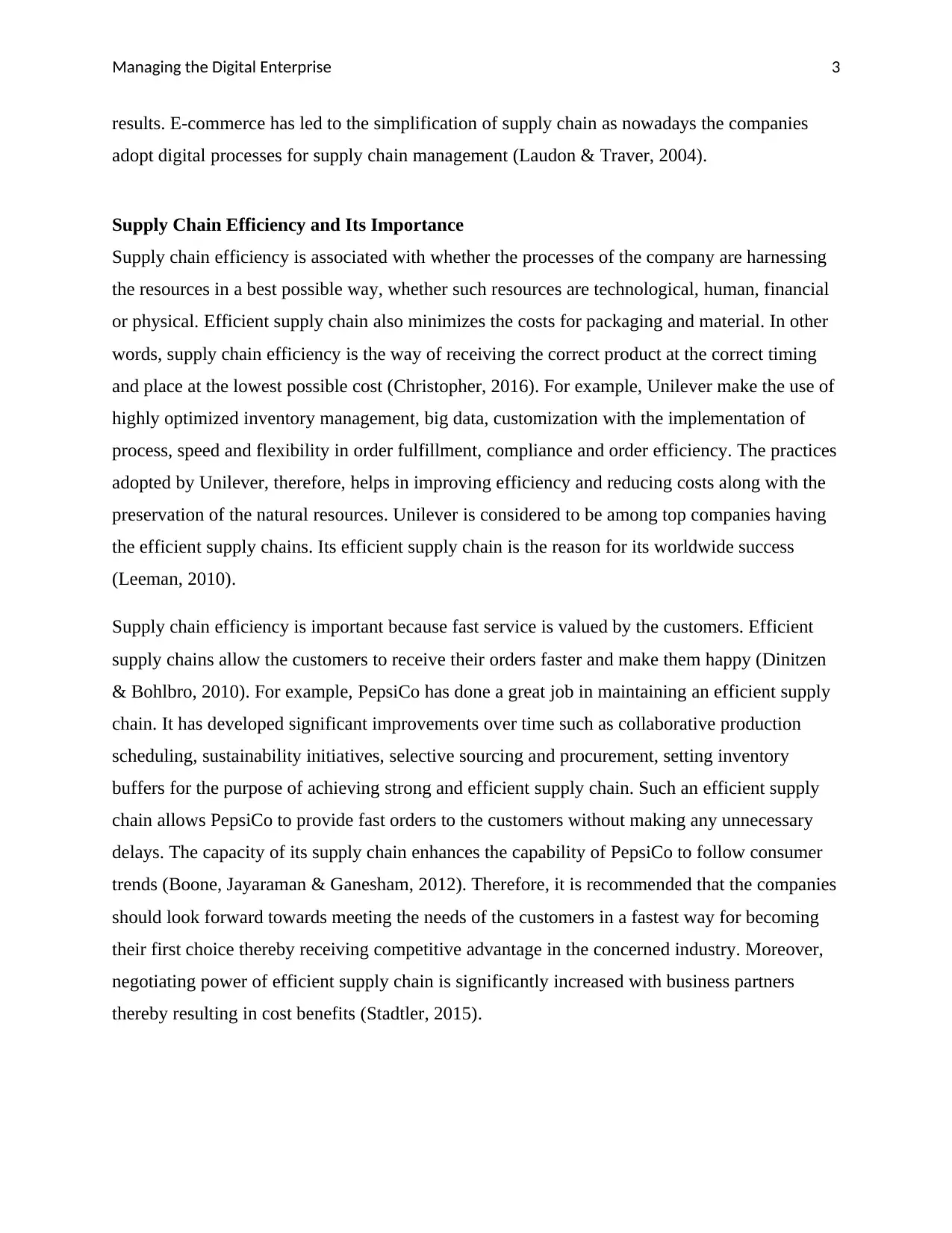
Managing the Digital Enterprise 3
results. E-commerce has led to the simplification of supply chain as nowadays the companies
adopt digital processes for supply chain management (Laudon & Traver, 2004).
Supply Chain Efficiency and Its Importance
Supply chain efficiency is associated with whether the processes of the company are harnessing
the resources in a best possible way, whether such resources are technological, human, financial
or physical. Efficient supply chain also minimizes the costs for packaging and material. In other
words, supply chain efficiency is the way of receiving the correct product at the correct timing
and place at the lowest possible cost (Christopher, 2016). For example, Unilever make the use of
highly optimized inventory management, big data, customization with the implementation of
process, speed and flexibility in order fulfillment, compliance and order efficiency. The practices
adopted by Unilever, therefore, helps in improving efficiency and reducing costs along with the
preservation of the natural resources. Unilever is considered to be among top companies having
the efficient supply chains. Its efficient supply chain is the reason for its worldwide success
(Leeman, 2010).
Supply chain efficiency is important because fast service is valued by the customers. Efficient
supply chains allow the customers to receive their orders faster and make them happy (Dinitzen
& Bohlbro, 2010). For example, PepsiCo has done a great job in maintaining an efficient supply
chain. It has developed significant improvements over time such as collaborative production
scheduling, sustainability initiatives, selective sourcing and procurement, setting inventory
buffers for the purpose of achieving strong and efficient supply chain. Such an efficient supply
chain allows PepsiCo to provide fast orders to the customers without making any unnecessary
delays. The capacity of its supply chain enhances the capability of PepsiCo to follow consumer
trends (Boone, Jayaraman & Ganesham, 2012). Therefore, it is recommended that the companies
should look forward towards meeting the needs of the customers in a fastest way for becoming
their first choice thereby receiving competitive advantage in the concerned industry. Moreover,
negotiating power of efficient supply chain is significantly increased with business partners
thereby resulting in cost benefits (Stadtler, 2015).
results. E-commerce has led to the simplification of supply chain as nowadays the companies
adopt digital processes for supply chain management (Laudon & Traver, 2004).
Supply Chain Efficiency and Its Importance
Supply chain efficiency is associated with whether the processes of the company are harnessing
the resources in a best possible way, whether such resources are technological, human, financial
or physical. Efficient supply chain also minimizes the costs for packaging and material. In other
words, supply chain efficiency is the way of receiving the correct product at the correct timing
and place at the lowest possible cost (Christopher, 2016). For example, Unilever make the use of
highly optimized inventory management, big data, customization with the implementation of
process, speed and flexibility in order fulfillment, compliance and order efficiency. The practices
adopted by Unilever, therefore, helps in improving efficiency and reducing costs along with the
preservation of the natural resources. Unilever is considered to be among top companies having
the efficient supply chains. Its efficient supply chain is the reason for its worldwide success
(Leeman, 2010).
Supply chain efficiency is important because fast service is valued by the customers. Efficient
supply chains allow the customers to receive their orders faster and make them happy (Dinitzen
& Bohlbro, 2010). For example, PepsiCo has done a great job in maintaining an efficient supply
chain. It has developed significant improvements over time such as collaborative production
scheduling, sustainability initiatives, selective sourcing and procurement, setting inventory
buffers for the purpose of achieving strong and efficient supply chain. Such an efficient supply
chain allows PepsiCo to provide fast orders to the customers without making any unnecessary
delays. The capacity of its supply chain enhances the capability of PepsiCo to follow consumer
trends (Boone, Jayaraman & Ganesham, 2012). Therefore, it is recommended that the companies
should look forward towards meeting the needs of the customers in a fastest way for becoming
their first choice thereby receiving competitive advantage in the concerned industry. Moreover,
negotiating power of efficient supply chain is significantly increased with business partners
thereby resulting in cost benefits (Stadtler, 2015).
Paraphrase This Document
Need a fresh take? Get an instant paraphrase of this document with our AI Paraphraser
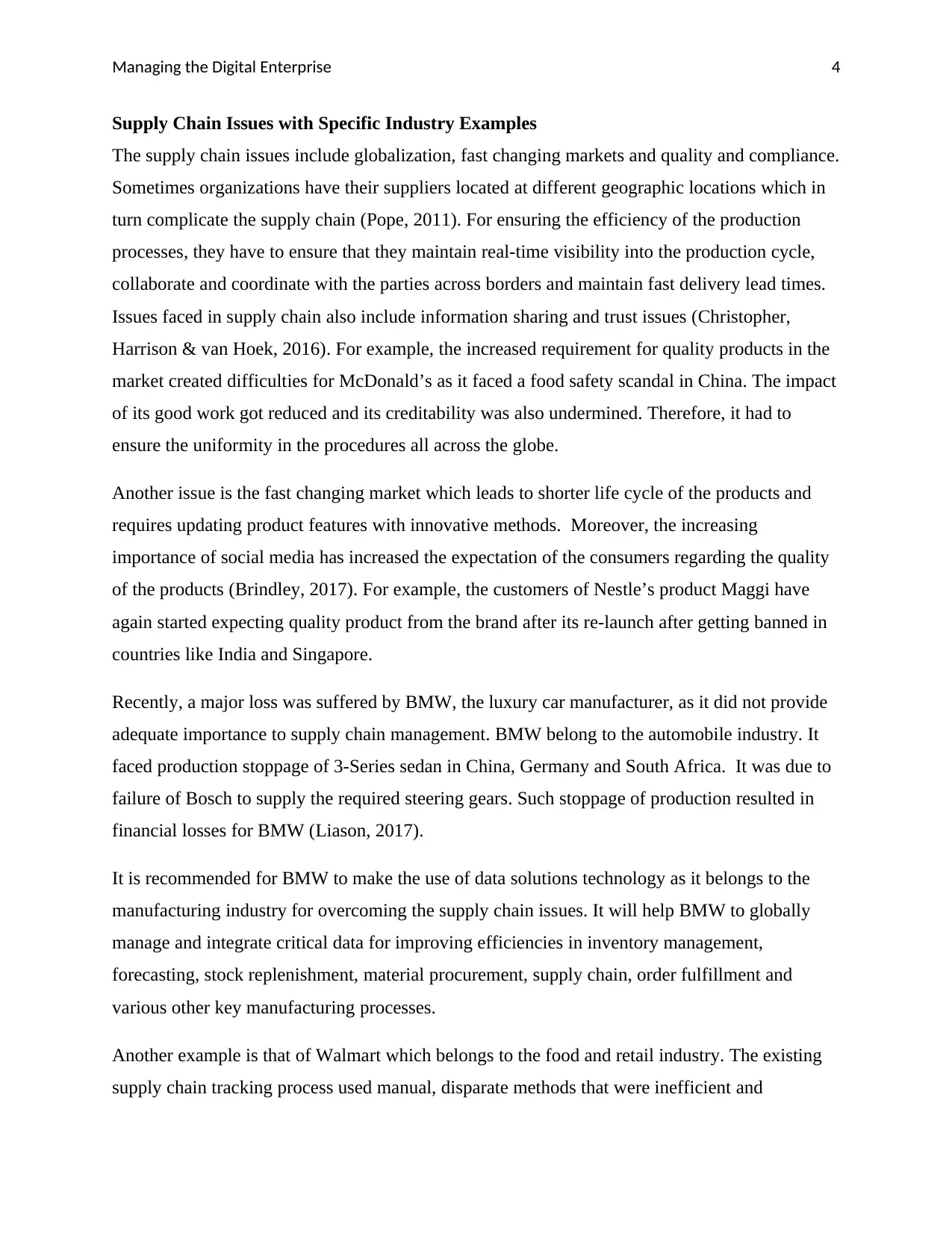
Managing the Digital Enterprise 4
Supply Chain Issues with Specific Industry Examples
The supply chain issues include globalization, fast changing markets and quality and compliance.
Sometimes organizations have their suppliers located at different geographic locations which in
turn complicate the supply chain (Pope, 2011). For ensuring the efficiency of the production
processes, they have to ensure that they maintain real-time visibility into the production cycle,
collaborate and coordinate with the parties across borders and maintain fast delivery lead times.
Issues faced in supply chain also include information sharing and trust issues (Christopher,
Harrison & van Hoek, 2016). For example, the increased requirement for quality products in the
market created difficulties for McDonald’s as it faced a food safety scandal in China. The impact
of its good work got reduced and its creditability was also undermined. Therefore, it had to
ensure the uniformity in the procedures all across the globe.
Another issue is the fast changing market which leads to shorter life cycle of the products and
requires updating product features with innovative methods. Moreover, the increasing
importance of social media has increased the expectation of the consumers regarding the quality
of the products (Brindley, 2017). For example, the customers of Nestle’s product Maggi have
again started expecting quality product from the brand after its re-launch after getting banned in
countries like India and Singapore.
Recently, a major loss was suffered by BMW, the luxury car manufacturer, as it did not provide
adequate importance to supply chain management. BMW belong to the automobile industry. It
faced production stoppage of 3-Series sedan in China, Germany and South Africa. It was due to
failure of Bosch to supply the required steering gears. Such stoppage of production resulted in
financial losses for BMW (Liason, 2017).
It is recommended for BMW to make the use of data solutions technology as it belongs to the
manufacturing industry for overcoming the supply chain issues. It will help BMW to globally
manage and integrate critical data for improving efficiencies in inventory management,
forecasting, stock replenishment, material procurement, supply chain, order fulfillment and
various other key manufacturing processes.
Another example is that of Walmart which belongs to the food and retail industry. The existing
supply chain tracking process used manual, disparate methods that were inefficient and
Supply Chain Issues with Specific Industry Examples
The supply chain issues include globalization, fast changing markets and quality and compliance.
Sometimes organizations have their suppliers located at different geographic locations which in
turn complicate the supply chain (Pope, 2011). For ensuring the efficiency of the production
processes, they have to ensure that they maintain real-time visibility into the production cycle,
collaborate and coordinate with the parties across borders and maintain fast delivery lead times.
Issues faced in supply chain also include information sharing and trust issues (Christopher,
Harrison & van Hoek, 2016). For example, the increased requirement for quality products in the
market created difficulties for McDonald’s as it faced a food safety scandal in China. The impact
of its good work got reduced and its creditability was also undermined. Therefore, it had to
ensure the uniformity in the procedures all across the globe.
Another issue is the fast changing market which leads to shorter life cycle of the products and
requires updating product features with innovative methods. Moreover, the increasing
importance of social media has increased the expectation of the consumers regarding the quality
of the products (Brindley, 2017). For example, the customers of Nestle’s product Maggi have
again started expecting quality product from the brand after its re-launch after getting banned in
countries like India and Singapore.
Recently, a major loss was suffered by BMW, the luxury car manufacturer, as it did not provide
adequate importance to supply chain management. BMW belong to the automobile industry. It
faced production stoppage of 3-Series sedan in China, Germany and South Africa. It was due to
failure of Bosch to supply the required steering gears. Such stoppage of production resulted in
financial losses for BMW (Liason, 2017).
It is recommended for BMW to make the use of data solutions technology as it belongs to the
manufacturing industry for overcoming the supply chain issues. It will help BMW to globally
manage and integrate critical data for improving efficiencies in inventory management,
forecasting, stock replenishment, material procurement, supply chain, order fulfillment and
various other key manufacturing processes.
Another example is that of Walmart which belongs to the food and retail industry. The existing
supply chain tracking process used manual, disparate methods that were inefficient and
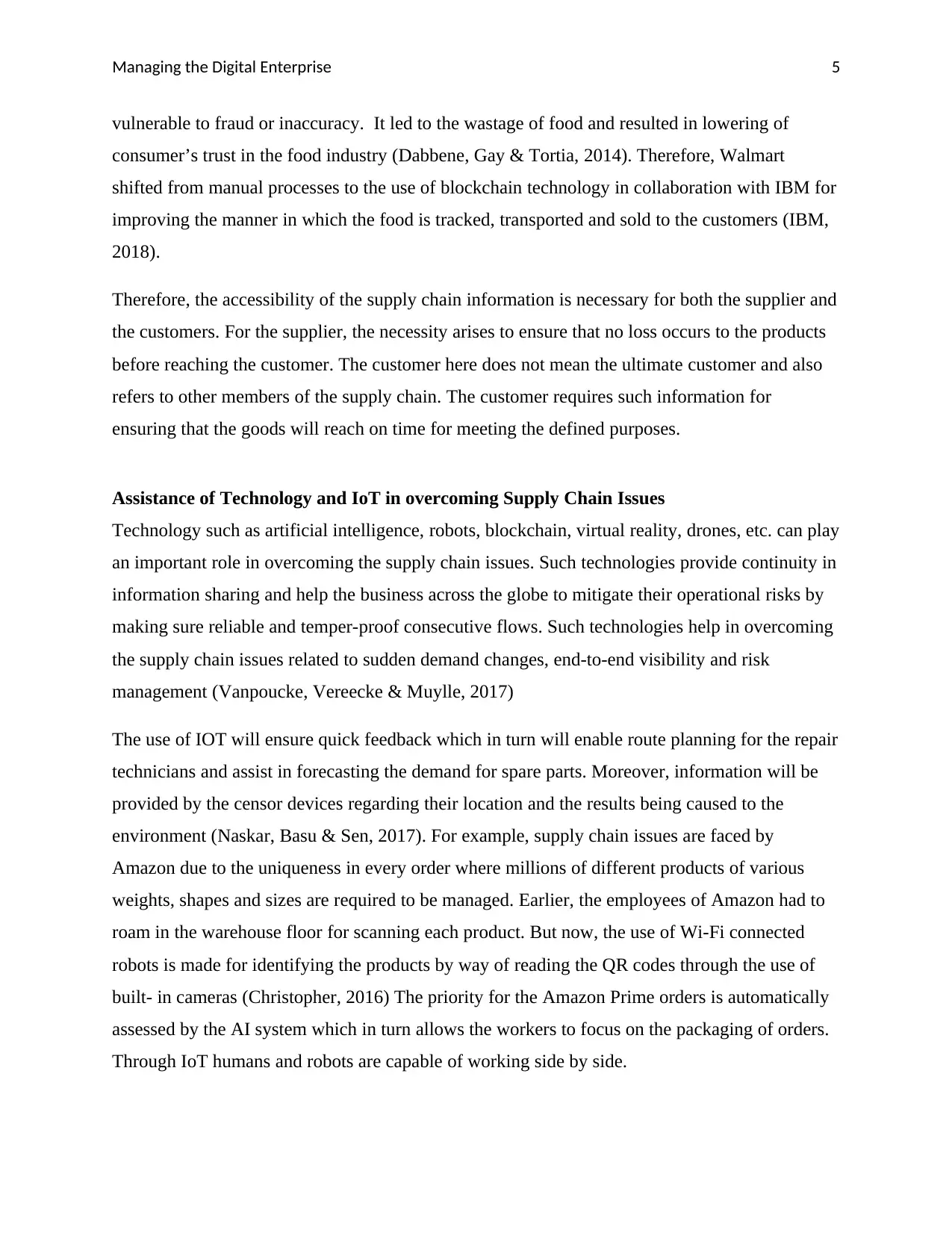
Managing the Digital Enterprise 5
vulnerable to fraud or inaccuracy. It led to the wastage of food and resulted in lowering of
consumer’s trust in the food industry (Dabbene, Gay & Tortia, 2014). Therefore, Walmart
shifted from manual processes to the use of blockchain technology in collaboration with IBM for
improving the manner in which the food is tracked, transported and sold to the customers (IBM,
2018).
Therefore, the accessibility of the supply chain information is necessary for both the supplier and
the customers. For the supplier, the necessity arises to ensure that no loss occurs to the products
before reaching the customer. The customer here does not mean the ultimate customer and also
refers to other members of the supply chain. The customer requires such information for
ensuring that the goods will reach on time for meeting the defined purposes.
Assistance of Technology and IoT in overcoming Supply Chain Issues
Technology such as artificial intelligence, robots, blockchain, virtual reality, drones, etc. can play
an important role in overcoming the supply chain issues. Such technologies provide continuity in
information sharing and help the business across the globe to mitigate their operational risks by
making sure reliable and temper-proof consecutive flows. Such technologies help in overcoming
the supply chain issues related to sudden demand changes, end-to-end visibility and risk
management (Vanpoucke, Vereecke & Muylle, 2017)
The use of IOT will ensure quick feedback which in turn will enable route planning for the repair
technicians and assist in forecasting the demand for spare parts. Moreover, information will be
provided by the censor devices regarding their location and the results being caused to the
environment (Naskar, Basu & Sen, 2017). For example, supply chain issues are faced by
Amazon due to the uniqueness in every order where millions of different products of various
weights, shapes and sizes are required to be managed. Earlier, the employees of Amazon had to
roam in the warehouse floor for scanning each product. But now, the use of Wi-Fi connected
robots is made for identifying the products by way of reading the QR codes through the use of
built- in cameras (Christopher, 2016) The priority for the Amazon Prime orders is automatically
assessed by the AI system which in turn allows the workers to focus on the packaging of orders.
Through IoT humans and robots are capable of working side by side.
vulnerable to fraud or inaccuracy. It led to the wastage of food and resulted in lowering of
consumer’s trust in the food industry (Dabbene, Gay & Tortia, 2014). Therefore, Walmart
shifted from manual processes to the use of blockchain technology in collaboration with IBM for
improving the manner in which the food is tracked, transported and sold to the customers (IBM,
2018).
Therefore, the accessibility of the supply chain information is necessary for both the supplier and
the customers. For the supplier, the necessity arises to ensure that no loss occurs to the products
before reaching the customer. The customer here does not mean the ultimate customer and also
refers to other members of the supply chain. The customer requires such information for
ensuring that the goods will reach on time for meeting the defined purposes.
Assistance of Technology and IoT in overcoming Supply Chain Issues
Technology such as artificial intelligence, robots, blockchain, virtual reality, drones, etc. can play
an important role in overcoming the supply chain issues. Such technologies provide continuity in
information sharing and help the business across the globe to mitigate their operational risks by
making sure reliable and temper-proof consecutive flows. Such technologies help in overcoming
the supply chain issues related to sudden demand changes, end-to-end visibility and risk
management (Vanpoucke, Vereecke & Muylle, 2017)
The use of IOT will ensure quick feedback which in turn will enable route planning for the repair
technicians and assist in forecasting the demand for spare parts. Moreover, information will be
provided by the censor devices regarding their location and the results being caused to the
environment (Naskar, Basu & Sen, 2017). For example, supply chain issues are faced by
Amazon due to the uniqueness in every order where millions of different products of various
weights, shapes and sizes are required to be managed. Earlier, the employees of Amazon had to
roam in the warehouse floor for scanning each product. But now, the use of Wi-Fi connected
robots is made for identifying the products by way of reading the QR codes through the use of
built- in cameras (Christopher, 2016) The priority for the Amazon Prime orders is automatically
assessed by the AI system which in turn allows the workers to focus on the packaging of orders.
Through IoT humans and robots are capable of working side by side.
⊘ This is a preview!⊘
Do you want full access?
Subscribe today to unlock all pages.

Trusted by 1+ million students worldwide
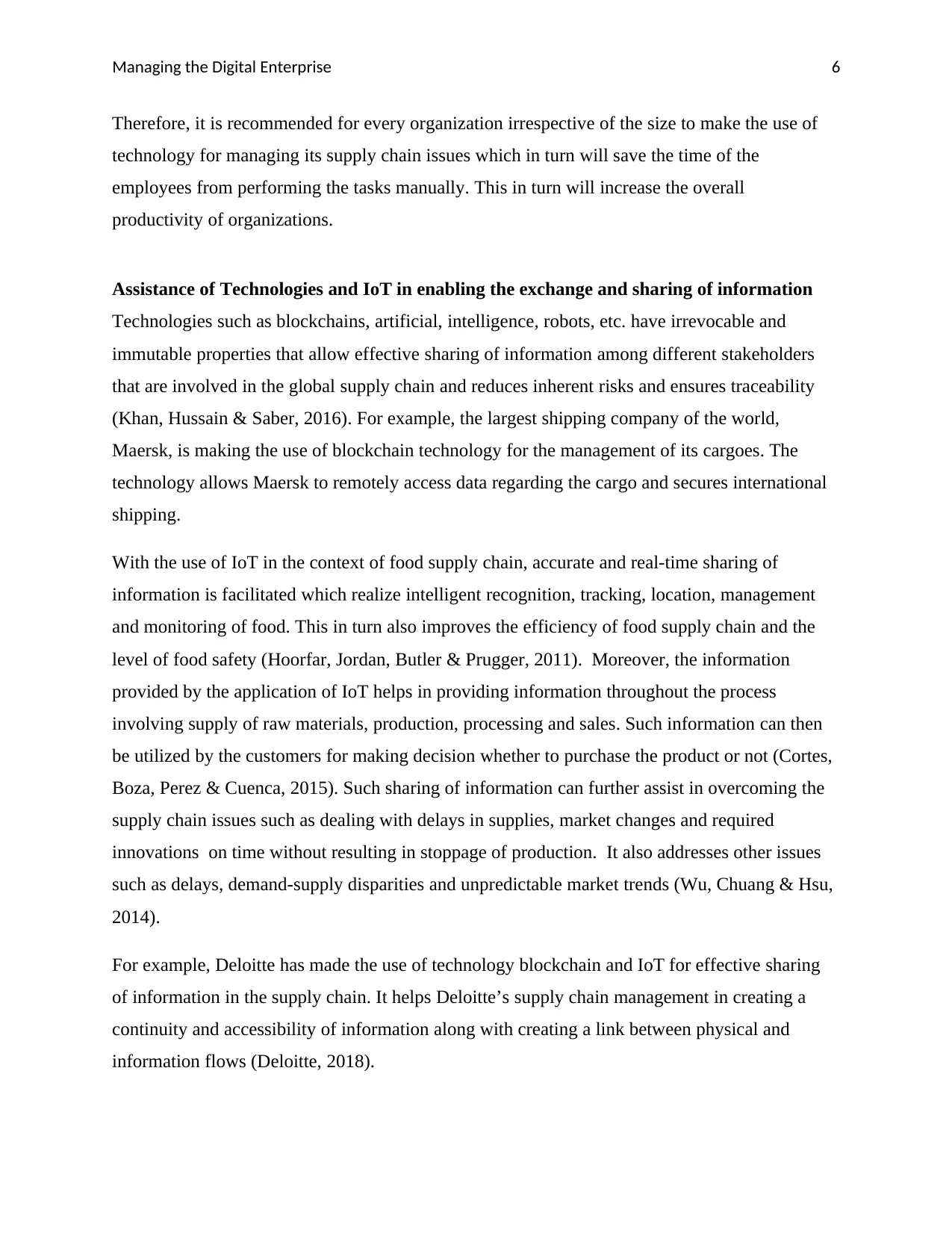
Managing the Digital Enterprise 6
Therefore, it is recommended for every organization irrespective of the size to make the use of
technology for managing its supply chain issues which in turn will save the time of the
employees from performing the tasks manually. This in turn will increase the overall
productivity of organizations.
Assistance of Technologies and IoT in enabling the exchange and sharing of information
Technologies such as blockchains, artificial, intelligence, robots, etc. have irrevocable and
immutable properties that allow effective sharing of information among different stakeholders
that are involved in the global supply chain and reduces inherent risks and ensures traceability
(Khan, Hussain & Saber, 2016). For example, the largest shipping company of the world,
Maersk, is making the use of blockchain technology for the management of its cargoes. The
technology allows Maersk to remotely access data regarding the cargo and secures international
shipping.
With the use of IoT in the context of food supply chain, accurate and real-time sharing of
information is facilitated which realize intelligent recognition, tracking, location, management
and monitoring of food. This in turn also improves the efficiency of food supply chain and the
level of food safety (Hoorfar, Jordan, Butler & Prugger, 2011). Moreover, the information
provided by the application of IoT helps in providing information throughout the process
involving supply of raw materials, production, processing and sales. Such information can then
be utilized by the customers for making decision whether to purchase the product or not (Cortes,
Boza, Perez & Cuenca, 2015). Such sharing of information can further assist in overcoming the
supply chain issues such as dealing with delays in supplies, market changes and required
innovations on time without resulting in stoppage of production. It also addresses other issues
such as delays, demand-supply disparities and unpredictable market trends (Wu, Chuang & Hsu,
2014).
For example, Deloitte has made the use of technology blockchain and IoT for effective sharing
of information in the supply chain. It helps Deloitte’s supply chain management in creating a
continuity and accessibility of information along with creating a link between physical and
information flows (Deloitte, 2018).
Therefore, it is recommended for every organization irrespective of the size to make the use of
technology for managing its supply chain issues which in turn will save the time of the
employees from performing the tasks manually. This in turn will increase the overall
productivity of organizations.
Assistance of Technologies and IoT in enabling the exchange and sharing of information
Technologies such as blockchains, artificial, intelligence, robots, etc. have irrevocable and
immutable properties that allow effective sharing of information among different stakeholders
that are involved in the global supply chain and reduces inherent risks and ensures traceability
(Khan, Hussain & Saber, 2016). For example, the largest shipping company of the world,
Maersk, is making the use of blockchain technology for the management of its cargoes. The
technology allows Maersk to remotely access data regarding the cargo and secures international
shipping.
With the use of IoT in the context of food supply chain, accurate and real-time sharing of
information is facilitated which realize intelligent recognition, tracking, location, management
and monitoring of food. This in turn also improves the efficiency of food supply chain and the
level of food safety (Hoorfar, Jordan, Butler & Prugger, 2011). Moreover, the information
provided by the application of IoT helps in providing information throughout the process
involving supply of raw materials, production, processing and sales. Such information can then
be utilized by the customers for making decision whether to purchase the product or not (Cortes,
Boza, Perez & Cuenca, 2015). Such sharing of information can further assist in overcoming the
supply chain issues such as dealing with delays in supplies, market changes and required
innovations on time without resulting in stoppage of production. It also addresses other issues
such as delays, demand-supply disparities and unpredictable market trends (Wu, Chuang & Hsu,
2014).
For example, Deloitte has made the use of technology blockchain and IoT for effective sharing
of information in the supply chain. It helps Deloitte’s supply chain management in creating a
continuity and accessibility of information along with creating a link between physical and
information flows (Deloitte, 2018).
Paraphrase This Document
Need a fresh take? Get an instant paraphrase of this document with our AI Paraphraser
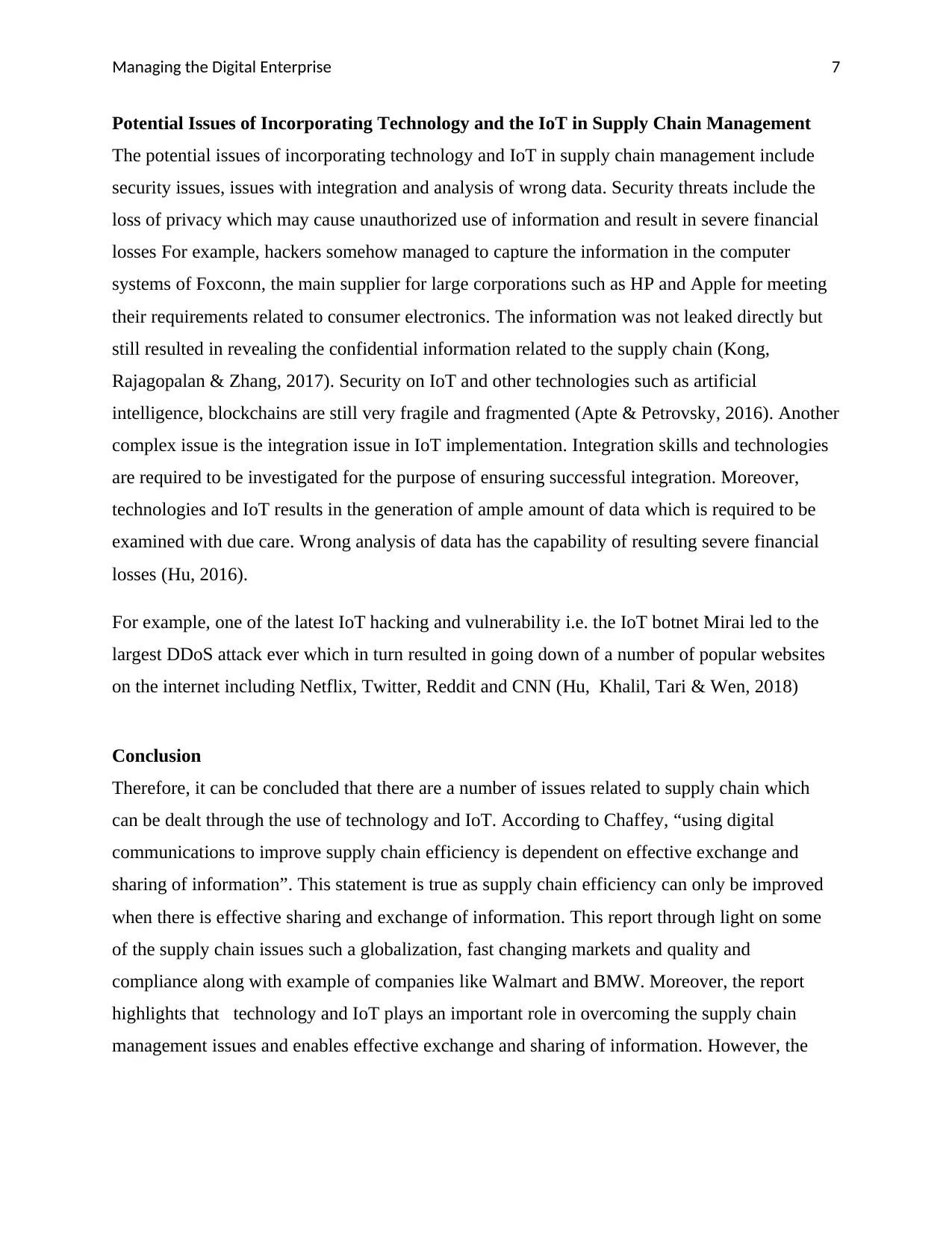
Managing the Digital Enterprise 7
Potential Issues of Incorporating Technology and the IoT in Supply Chain Management
The potential issues of incorporating technology and IoT in supply chain management include
security issues, issues with integration and analysis of wrong data. Security threats include the
loss of privacy which may cause unauthorized use of information and result in severe financial
losses For example, hackers somehow managed to capture the information in the computer
systems of Foxconn, the main supplier for large corporations such as HP and Apple for meeting
their requirements related to consumer electronics. The information was not leaked directly but
still resulted in revealing the confidential information related to the supply chain (Kong,
Rajagopalan & Zhang, 2017). Security on IoT and other technologies such as artificial
intelligence, blockchains are still very fragile and fragmented (Apte & Petrovsky, 2016). Another
complex issue is the integration issue in IoT implementation. Integration skills and technologies
are required to be investigated for the purpose of ensuring successful integration. Moreover,
technologies and IoT results in the generation of ample amount of data which is required to be
examined with due care. Wrong analysis of data has the capability of resulting severe financial
losses (Hu, 2016).
For example, one of the latest IoT hacking and vulnerability i.e. the IoT botnet Mirai led to the
largest DDoS attack ever which in turn resulted in going down of a number of popular websites
on the internet including Netflix, Twitter, Reddit and CNN (Hu, Khalil, Tari & Wen, 2018)
Conclusion
Therefore, it can be concluded that there are a number of issues related to supply chain which
can be dealt through the use of technology and IoT. According to Chaffey, “using digital
communications to improve supply chain efficiency is dependent on effective exchange and
sharing of information”. This statement is true as supply chain efficiency can only be improved
when there is effective sharing and exchange of information. This report through light on some
of the supply chain issues such a globalization, fast changing markets and quality and
compliance along with example of companies like Walmart and BMW. Moreover, the report
highlights that technology and IoT plays an important role in overcoming the supply chain
management issues and enables effective exchange and sharing of information. However, the
Potential Issues of Incorporating Technology and the IoT in Supply Chain Management
The potential issues of incorporating technology and IoT in supply chain management include
security issues, issues with integration and analysis of wrong data. Security threats include the
loss of privacy which may cause unauthorized use of information and result in severe financial
losses For example, hackers somehow managed to capture the information in the computer
systems of Foxconn, the main supplier for large corporations such as HP and Apple for meeting
their requirements related to consumer electronics. The information was not leaked directly but
still resulted in revealing the confidential information related to the supply chain (Kong,
Rajagopalan & Zhang, 2017). Security on IoT and other technologies such as artificial
intelligence, blockchains are still very fragile and fragmented (Apte & Petrovsky, 2016). Another
complex issue is the integration issue in IoT implementation. Integration skills and technologies
are required to be investigated for the purpose of ensuring successful integration. Moreover,
technologies and IoT results in the generation of ample amount of data which is required to be
examined with due care. Wrong analysis of data has the capability of resulting severe financial
losses (Hu, 2016).
For example, one of the latest IoT hacking and vulnerability i.e. the IoT botnet Mirai led to the
largest DDoS attack ever which in turn resulted in going down of a number of popular websites
on the internet including Netflix, Twitter, Reddit and CNN (Hu, Khalil, Tari & Wen, 2018)
Conclusion
Therefore, it can be concluded that there are a number of issues related to supply chain which
can be dealt through the use of technology and IoT. According to Chaffey, “using digital
communications to improve supply chain efficiency is dependent on effective exchange and
sharing of information”. This statement is true as supply chain efficiency can only be improved
when there is effective sharing and exchange of information. This report through light on some
of the supply chain issues such a globalization, fast changing markets and quality and
compliance along with example of companies like Walmart and BMW. Moreover, the report
highlights that technology and IoT plays an important role in overcoming the supply chain
management issues and enables effective exchange and sharing of information. However, the
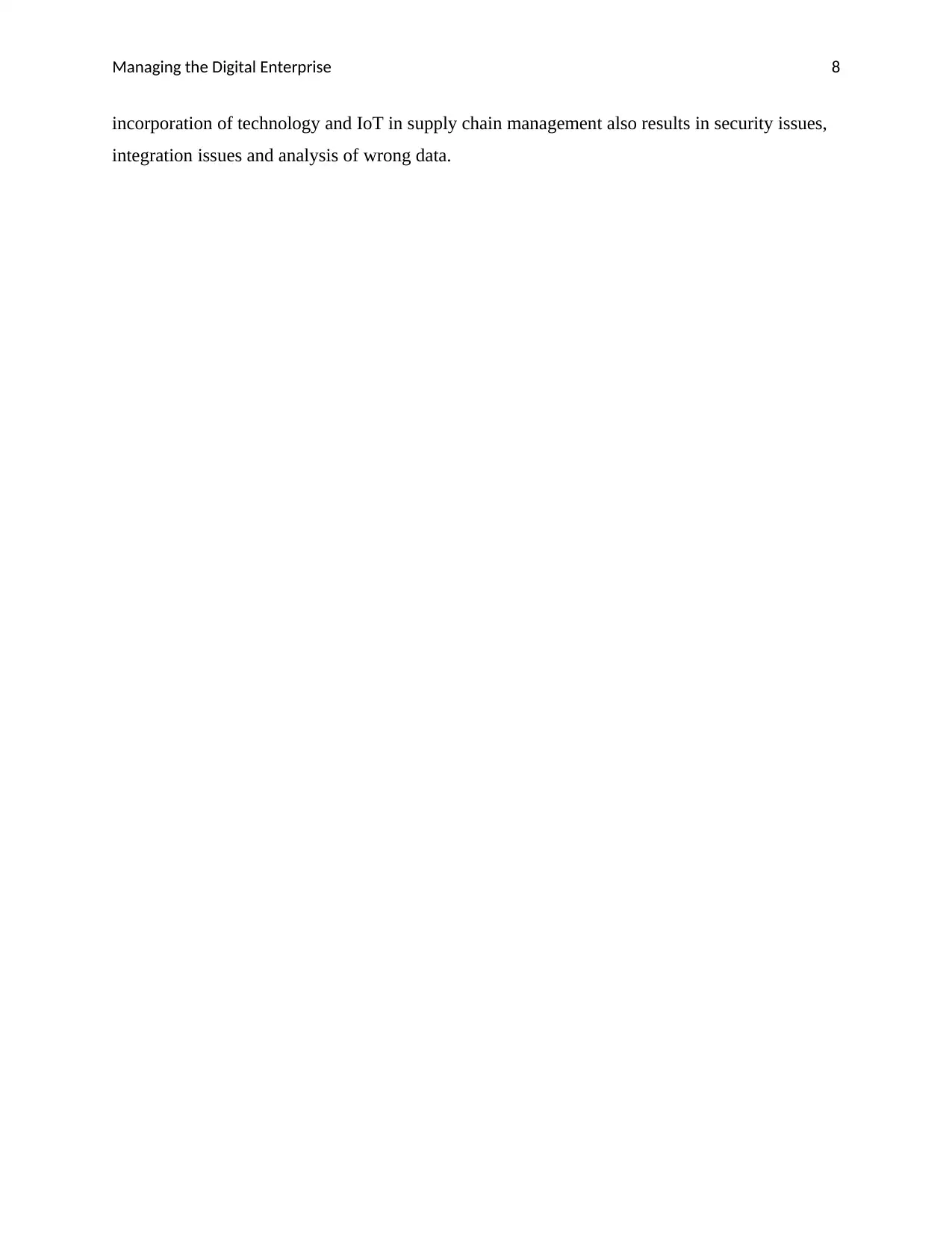
Managing the Digital Enterprise 8
incorporation of technology and IoT in supply chain management also results in security issues,
integration issues and analysis of wrong data.
incorporation of technology and IoT in supply chain management also results in security issues,
integration issues and analysis of wrong data.
⊘ This is a preview!⊘
Do you want full access?
Subscribe today to unlock all pages.

Trusted by 1+ million students worldwide
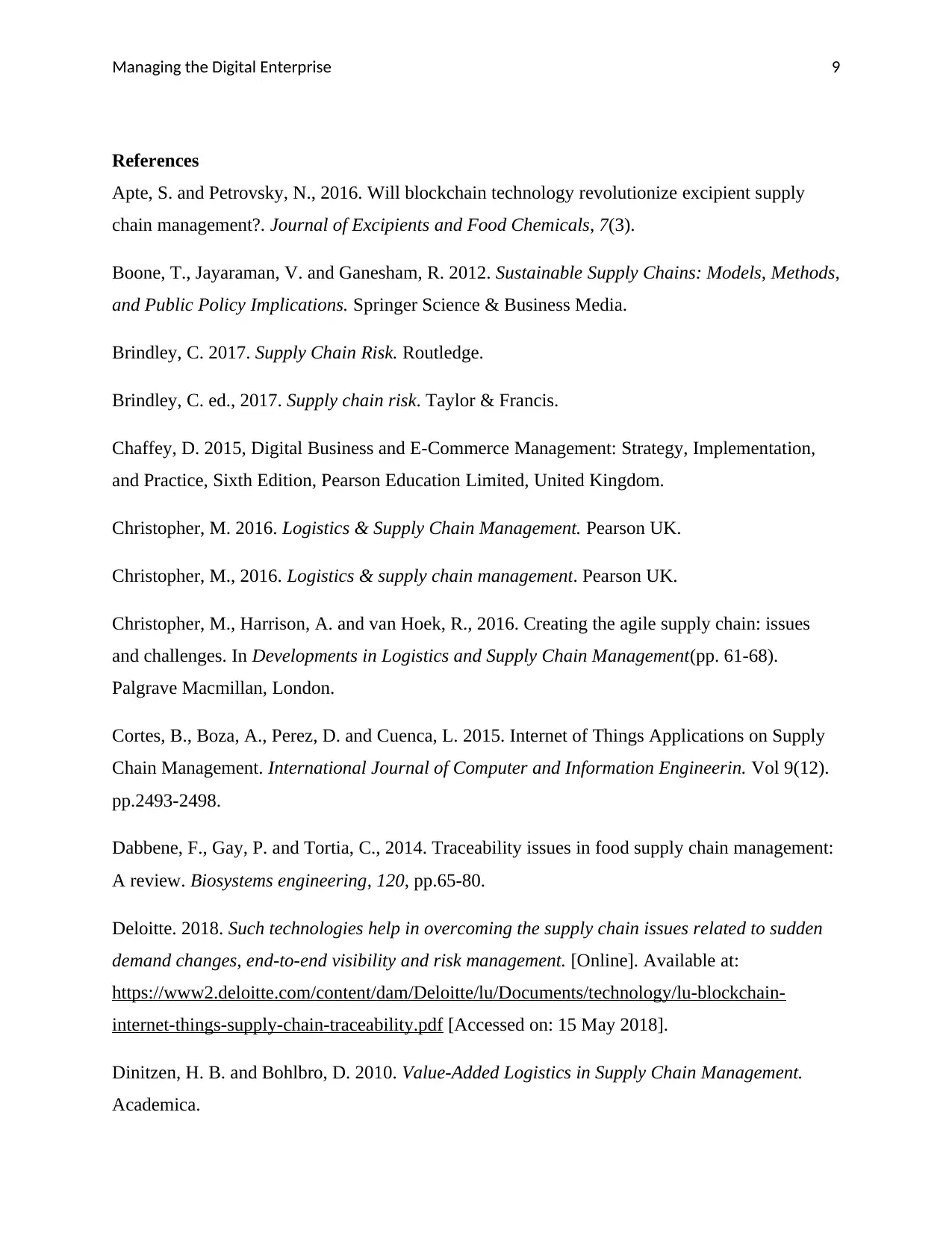
Managing the Digital Enterprise 9
References
Apte, S. and Petrovsky, N., 2016. Will blockchain technology revolutionize excipient supply
chain management?. Journal of Excipients and Food Chemicals, 7(3).
Boone, T., Jayaraman, V. and Ganesham, R. 2012. Sustainable Supply Chains: Models, Methods,
and Public Policy Implications. Springer Science & Business Media.
Brindley, C. 2017. Supply Chain Risk. Routledge.
Brindley, C. ed., 2017. Supply chain risk. Taylor & Francis.
Chaffey, D. 2015, Digital Business and E-Commerce Management: Strategy, Implementation,
and Practice, Sixth Edition, Pearson Education Limited, United Kingdom.
Christopher, M. 2016. Logistics & Supply Chain Management. Pearson UK.
Christopher, M., 2016. Logistics & supply chain management. Pearson UK.
Christopher, M., Harrison, A. and van Hoek, R., 2016. Creating the agile supply chain: issues
and challenges. In Developments in Logistics and Supply Chain Management(pp. 61-68).
Palgrave Macmillan, London.
Cortes, B., Boza, A., Perez, D. and Cuenca, L. 2015. Internet of Things Applications on Supply
Chain Management. International Journal of Computer and Information Engineerin. Vol 9(12).
pp.2493-2498.
Dabbene, F., Gay, P. and Tortia, C., 2014. Traceability issues in food supply chain management:
A review. Biosystems engineering, 120, pp.65-80.
Deloitte. 2018. Such technologies help in overcoming the supply chain issues related to sudden
demand changes, end-to-end visibility and risk management. [Online]. Available at:
https://www2.deloitte.com/content/dam/Deloitte/lu/Documents/technology/lu-blockchain-
internet-things-supply-chain-traceability.pdf [Accessed on: 15 May 2018].
Dinitzen, H. B. and Bohlbro, D. 2010. Value-Added Logistics in Supply Chain Management.
Academica.
References
Apte, S. and Petrovsky, N., 2016. Will blockchain technology revolutionize excipient supply
chain management?. Journal of Excipients and Food Chemicals, 7(3).
Boone, T., Jayaraman, V. and Ganesham, R. 2012. Sustainable Supply Chains: Models, Methods,
and Public Policy Implications. Springer Science & Business Media.
Brindley, C. 2017. Supply Chain Risk. Routledge.
Brindley, C. ed., 2017. Supply chain risk. Taylor & Francis.
Chaffey, D. 2015, Digital Business and E-Commerce Management: Strategy, Implementation,
and Practice, Sixth Edition, Pearson Education Limited, United Kingdom.
Christopher, M. 2016. Logistics & Supply Chain Management. Pearson UK.
Christopher, M., 2016. Logistics & supply chain management. Pearson UK.
Christopher, M., Harrison, A. and van Hoek, R., 2016. Creating the agile supply chain: issues
and challenges. In Developments in Logistics and Supply Chain Management(pp. 61-68).
Palgrave Macmillan, London.
Cortes, B., Boza, A., Perez, D. and Cuenca, L. 2015. Internet of Things Applications on Supply
Chain Management. International Journal of Computer and Information Engineerin. Vol 9(12).
pp.2493-2498.
Dabbene, F., Gay, P. and Tortia, C., 2014. Traceability issues in food supply chain management:
A review. Biosystems engineering, 120, pp.65-80.
Deloitte. 2018. Such technologies help in overcoming the supply chain issues related to sudden
demand changes, end-to-end visibility and risk management. [Online]. Available at:
https://www2.deloitte.com/content/dam/Deloitte/lu/Documents/technology/lu-blockchain-
internet-things-supply-chain-traceability.pdf [Accessed on: 15 May 2018].
Dinitzen, H. B. and Bohlbro, D. 2010. Value-Added Logistics in Supply Chain Management.
Academica.
Paraphrase This Document
Need a fresh take? Get an instant paraphrase of this document with our AI Paraphraser
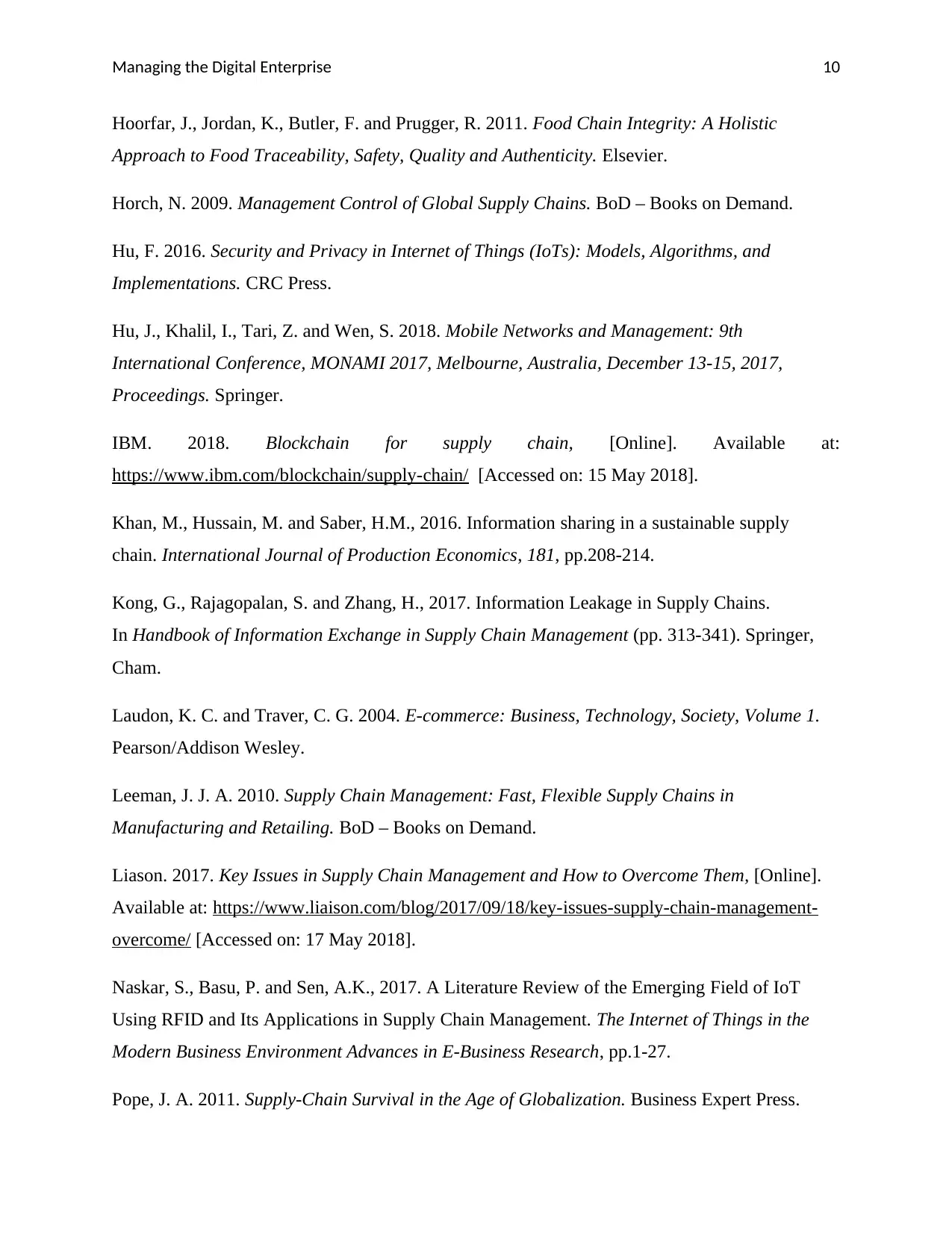
Managing the Digital Enterprise 10
Hoorfar, J., Jordan, K., Butler, F. and Prugger, R. 2011. Food Chain Integrity: A Holistic
Approach to Food Traceability, Safety, Quality and Authenticity. Elsevier.
Horch, N. 2009. Management Control of Global Supply Chains. BoD – Books on Demand.
Hu, F. 2016. Security and Privacy in Internet of Things (IoTs): Models, Algorithms, and
Implementations. CRC Press.
Hu, J., Khalil, I., Tari, Z. and Wen, S. 2018. Mobile Networks and Management: 9th
International Conference, MONAMI 2017, Melbourne, Australia, December 13-15, 2017,
Proceedings. Springer.
IBM. 2018. Blockchain for supply chain, [Online]. Available at:
https://www.ibm.com/blockchain/supply-chain/ [Accessed on: 15 May 2018].
Khan, M., Hussain, M. and Saber, H.M., 2016. Information sharing in a sustainable supply
chain. International Journal of Production Economics, 181, pp.208-214.
Kong, G., Rajagopalan, S. and Zhang, H., 2017. Information Leakage in Supply Chains.
In Handbook of Information Exchange in Supply Chain Management (pp. 313-341). Springer,
Cham.
Laudon, K. C. and Traver, C. G. 2004. E-commerce: Business, Technology, Society, Volume 1.
Pearson/Addison Wesley.
Leeman, J. J. A. 2010. Supply Chain Management: Fast, Flexible Supply Chains in
Manufacturing and Retailing. BoD – Books on Demand.
Liason. 2017. Key Issues in Supply Chain Management and How to Overcome Them, [Online].
Available at: https://www.liaison.com/blog/2017/09/18/key-issues-supply-chain-management-
overcome/ [Accessed on: 17 May 2018].
Naskar, S., Basu, P. and Sen, A.K., 2017. A Literature Review of the Emerging Field of IoT
Using RFID and Its Applications in Supply Chain Management. The Internet of Things in the
Modern Business Environment Advances in E-Business Research, pp.1-27.
Pope, J. A. 2011. Supply-Chain Survival in the Age of Globalization. Business Expert Press.
Hoorfar, J., Jordan, K., Butler, F. and Prugger, R. 2011. Food Chain Integrity: A Holistic
Approach to Food Traceability, Safety, Quality and Authenticity. Elsevier.
Horch, N. 2009. Management Control of Global Supply Chains. BoD – Books on Demand.
Hu, F. 2016. Security and Privacy in Internet of Things (IoTs): Models, Algorithms, and
Implementations. CRC Press.
Hu, J., Khalil, I., Tari, Z. and Wen, S. 2018. Mobile Networks and Management: 9th
International Conference, MONAMI 2017, Melbourne, Australia, December 13-15, 2017,
Proceedings. Springer.
IBM. 2018. Blockchain for supply chain, [Online]. Available at:
https://www.ibm.com/blockchain/supply-chain/ [Accessed on: 15 May 2018].
Khan, M., Hussain, M. and Saber, H.M., 2016. Information sharing in a sustainable supply
chain. International Journal of Production Economics, 181, pp.208-214.
Kong, G., Rajagopalan, S. and Zhang, H., 2017. Information Leakage in Supply Chains.
In Handbook of Information Exchange in Supply Chain Management (pp. 313-341). Springer,
Cham.
Laudon, K. C. and Traver, C. G. 2004. E-commerce: Business, Technology, Society, Volume 1.
Pearson/Addison Wesley.
Leeman, J. J. A. 2010. Supply Chain Management: Fast, Flexible Supply Chains in
Manufacturing and Retailing. BoD – Books on Demand.
Liason. 2017. Key Issues in Supply Chain Management and How to Overcome Them, [Online].
Available at: https://www.liaison.com/blog/2017/09/18/key-issues-supply-chain-management-
overcome/ [Accessed on: 17 May 2018].
Naskar, S., Basu, P. and Sen, A.K., 2017. A Literature Review of the Emerging Field of IoT
Using RFID and Its Applications in Supply Chain Management. The Internet of Things in the
Modern Business Environment Advances in E-Business Research, pp.1-27.
Pope, J. A. 2011. Supply-Chain Survival in the Age of Globalization. Business Expert Press.

Managing the Digital Enterprise 11
Stadtler, H., 2015. Supply chain management: An overview. In Supply chain management and
advanced planning (pp. 3-28). Springer, Berlin, Heidelberg.
Sun, Z. 2014. Handbook of Research on Demand-Driven Web Services: Theory, Technologies,
and Applications: Theory, Technologies, and Applications. IGI Global.
Vanpoucke, E., Vereecke, A. and Muylle, S., 2017. Leveraging the impact of supply chain
integration through information technology. International Journal of Operations & Production
Management, 37(4), pp.510-530.
Wang. J. 2012. Societal Impacts on Information Systems Development and Applications. IGI
Global.
Wu, L., Chuang, C.H. and Hsu, C.H., 2014. Information sharing and collaborative behaviors in
enabling supply chain performance: A social exchange perspective. International Journal of
Production Economics, 148, pp.122-132.
Stadtler, H., 2015. Supply chain management: An overview. In Supply chain management and
advanced planning (pp. 3-28). Springer, Berlin, Heidelberg.
Sun, Z. 2014. Handbook of Research on Demand-Driven Web Services: Theory, Technologies,
and Applications: Theory, Technologies, and Applications. IGI Global.
Vanpoucke, E., Vereecke, A. and Muylle, S., 2017. Leveraging the impact of supply chain
integration through information technology. International Journal of Operations & Production
Management, 37(4), pp.510-530.
Wang. J. 2012. Societal Impacts on Information Systems Development and Applications. IGI
Global.
Wu, L., Chuang, C.H. and Hsu, C.H., 2014. Information sharing and collaborative behaviors in
enabling supply chain performance: A social exchange perspective. International Journal of
Production Economics, 148, pp.122-132.
⊘ This is a preview!⊘
Do you want full access?
Subscribe today to unlock all pages.

Trusted by 1+ million students worldwide
1 out of 12
Related Documents
Your All-in-One AI-Powered Toolkit for Academic Success.
+13062052269
info@desklib.com
Available 24*7 on WhatsApp / Email
![[object Object]](/_next/static/media/star-bottom.7253800d.svg)
Unlock your academic potential
Copyright © 2020–2025 A2Z Services. All Rights Reserved. Developed and managed by ZUCOL.




